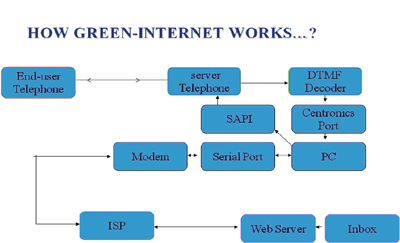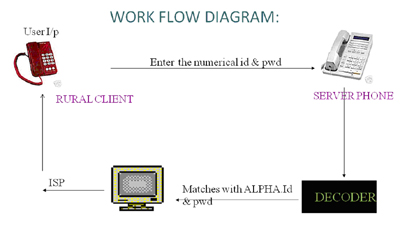Offline Green Internet
“INDIA is not POOR…..
ONLY INDIANS are POOR”…..
INDIA lives in villages. India has nearly 600000 villages(nearly 80% of population).There exists Rural-Urban DIGITAL DIVIDE. Rural people are unable to access ICT (Information & communication Technology).Rural people are those who may not know how to read and write. So its in the hands of budding engineers to empower them. Here we are bringing INTERNET facility to laymen in cost-effective AND eco-friendly manner.Thro’ this eco-friendly green-internet concept rural people can get Internet, climate, agro-based services real time. Here we have taken e-mail services for instance.
CURRENT SCENARIO:WHAT STATISTICS SAY->
Recent 15th census 2011 estimate says that India’s total population is 121 crore .Of the 121 crore out of which 83.3 crore live in rural areas while 37.7 crore stay in urban areas.According to data released by TRAI (Telecom Authority Of India) the number of telephone subscribers reached the level of 82.625 crore at the end of February 2011 as against 80.613 in January 2011.Also the Tele density(Number of telephone subscribers per 100 people) of the country has gone up to 69.29% at the end of February 2011. India ranks 48th among 138 nations in NRI (Networked Readiness Index) released at 10th global IT report (GITR) .this index estimates the capacity of using ICT’S for promoting economic development. So it’s a viable solution to bring INTERNET access thro’ our existing telephone network in order to provide solutions to rural problems in the areas such as climate ,agriculture and pollution.
OUR GOVERNMENT’S TARGETS-A GLANCE:
- Our government has declared 2011-2020 as decade of INNOVATION.
- UNO has set breaking the rural-urban digital divide as its one of the Millennium Development Goals(MNG).
- Under Bharat Nirman Scheme our government plans to enhance rural water supply, agriculture and rural connectivity for which budget-2011 allocation is 58000 crore.
- In our 12th five year plan (2012-2017) agricultural target is 4% ( currently we reached only 3%)
- Also our government plans to provide INTERNET connection to 500000 villages by 2014.
SOLUTION:1 PROPOSED GREEN INTERNET CONCEPT:
“Necessity is the mother of Inventions”
Information Technology(IT) is used for bridging the rural-urban digital-divide because of its simple ,easy to use, low-cost nature. In India as in many countries technological devices are not always owned but can be shared in an effective way. Is it possible to check E-mails without computer,without mobile phone,and without knowledge of computer, and even without Internet connection?Thro’ this innovative idea, Information Technology reaches even the layman in an effective manner. Here a dial-up client is received through the telephone line and authentication number is obtained from the user. Using this authentication number we get to the inbox of the client. The Inbox status is fetched to the buffer. Using a text to voice interface it is fed through the telephone line to the client. Finally the client(A layman) will be able to hear the mail.
INTRODUCTION:
The paper entitled “Offline Internet Accessing” is developed to receive E-Mail’s through landline. Phone-mail is the Hottest, Professional Telephony Product. Phone-mail is the professional real-time telephony product which lets you talk as a conventional telephone over the Internet without the cost associated with long distance calls. Phone-mail is a voice enabled user-friendly interface. Phone-mail allows you to receive mail with landline through the Internet or other TCP/IP based networks. Phone-mail is full duplex, encrypted, point-to-point communication that allows telephone-quality real-time audio. This mail server can be run on a visual basic environment using Ms-access as its backend.
ELECTRONIC MAIL ACCESSING:
The conventional system e-mails can be checked only through internet via computer. First and the foremost thing is to open the web browser it might be Internet Explorer, Mozilla Firefox etc. There is a need for user to type the necessary or the specified mail website address on the address bar and press the go button were the searching process is done. After the specified mail browser opens we have to log on to the domain and sign in using our alphanumerical user id and password. The connection establishment is tedious job and it takes a long time for processing .Also the mail server availability is difficult at times. After the retrieval process the person has to select the inbox where the number of mails is specified and select the particular mail among the mails. In the proposed system, we can check the mails by just making a telephone call to the proposed service. The user will have information about the mail status through the phone. The user will be able to access the mail box and will be able to hear mails from the place were the user resides. The de-merits of the existing system are,
- It requires Internet, computer ,other peripherals.
- Not suitable for Rural people (or) Layman .Also much cost is involved.
Also the generated heat leads to global warming and climate changes

MODULES :
- Telephone to e-mail service provider PC
- Authentication
- Email service provider to mail server
- Mail conveyor

Rate This Article:
Posted On: Thursday, 11 October, 2012 - 16:49
